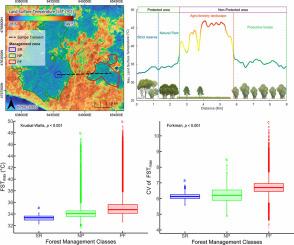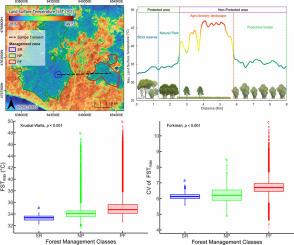Mediterranean strictly protected forests are cooler
IF 5.7
1区 农林科学
Q1 AGRONOMY
引用次数: 0
Abstract
Forests are essential for climate mitigation and adaptation strategies. While the thermal buffering role of old-growth forests is well known, the long-term cooling benefits of restored forests in strictly protected areas remain poorly understood, particularly in the Mediterranean region – a biodiversity hotspot severely affected by climate change. In this paper, we examined summer maximum canopy temperatures using satellite observations across a Mediterranean forest landscape in Tuscany (Italy) during the period 2013–2023. Our analysis focused on topographic and forest attributes influencing temperature variations among evergreen oak stands under different IUCN management categories (Ia and V) compared to coppiced stands outside protected areas. The Ia site, legally established in 1961, is the first strictly protected reserve in the coastal Mediterranean. We observed measurable differences in canopy cooling at the mesoclimatic scale among strictly protected (IUCN Ia), protected landscape (IUCN V), and productive forests. Unmanaged stands with taller structure exhibited cooler conditions, with average summer maxima of 33.3 °C in strictly protected areas versus 35.4 °C in actively managed forests. Linear regression and GAM models suggest that terrain (elevation, aspect, topographic position index), forest structure (canopy height, tree cover), functional traits (canopy moisture content, EVI) and forest edge effects were the main factors affecting canopy maximum temperature. Even after accounting for topographical and stand attributes, productive forests were 1 °C warmer than strictly protected areas, underlying specific properties that emerge as these stands recover towards more natural stages. Our findings confirm canopy temperature as a robust proxy for assessing forests’ biophysical role in moderating localized heat and evaluating restoration and conservation outcomes. This study underscores the urgent need to restore Mediterranean forests through strict protection, ensuring canopy-level thermal regulation and forest resilience. We advocate for area-based conservation and rewilding as essential nature-based solutions that integrate climate change mitigation and biodiversity protection within sustainable landscape management strategies.


地中海受到严格保护的森林更凉爽
森林对气候减缓和适应战略至关重要。虽然原始森林的热缓冲作用是众所周知的,但在严格保护的地区,特别是在受气候变化严重影响的生物多样性热点地中海地区,恢复森林的长期降温效益仍然知之甚少。在本文中,我们利用卫星观测研究了2013-2023年期间意大利托斯卡纳地中海森林景观的夏季最高冠层温度。我们的分析侧重于地形和森林属性对不同IUCN管理类别(Ia和V)下常绿栎林温度变化的影响,并与保护区外的覆被栎林进行比较。该保护区于1961年合法建立,是地中海沿岸第一个受到严格保护的保护区。在中气候尺度上,我们观察到了严格保护(IUCN Ia)、景观保护(IUCN V)和生产性森林在冠层冷却方面的可测量差异。高度较高的非管理林分表现出较低的气候条件,严格保护区的平均夏季最高温度为33.3°C,而积极管理林分的平均最高温度为35.4°C。线性回归和GAM模型表明,地形(高程、坡向、地形位置指数)、森林结构(冠层高度、树盖度)、功能性状(冠层含水量、EVI)和森林边缘效应是影响冠层最高温度的主要因素。即使在考虑地形和林分属性后,生产性森林也比严格保护区的温度高1°C,这是随着这些林分恢复到更自然的阶段而出现的潜在特性。我们的研究结果证实,冠层温度是评估森林在调节局部热量和评估恢复和保护结果方面的生物物理作用的有力指标。这项研究强调,迫切需要通过严格的保护来恢复地中海森林,确保冠层温度调节和森林恢复能力。我们提倡以区域为基础的保护和放归,作为基本的基于自然的解决方案,将减缓气候变化和保护生物多样性纳入可持续景观管理战略。
本文章由计算机程序翻译,如有差异,请以英文原文为准。
求助全文
约1分钟内获得全文
求助全文
来源期刊
CiteScore
10.30
自引率
9.70%
发文量
415
审稿时长
69 days
期刊介绍:
Agricultural and Forest Meteorology is an international journal for the publication of original articles and reviews on the inter-relationship between meteorology, agriculture, forestry, and natural ecosystems. Emphasis is on basic and applied scientific research relevant to practical problems in the field of plant and soil sciences, ecology and biogeochemistry as affected by weather as well as climate variability and change. Theoretical models should be tested against experimental data. Articles must appeal to an international audience. Special issues devoted to single topics are also published.
Typical topics include canopy micrometeorology (e.g. canopy radiation transfer, turbulence near the ground, evapotranspiration, energy balance, fluxes of trace gases), micrometeorological instrumentation (e.g., sensors for trace gases, flux measurement instruments, radiation measurement techniques), aerobiology (e.g. the dispersion of pollen, spores, insects and pesticides), biometeorology (e.g. the effect of weather and climate on plant distribution, crop yield, water-use efficiency, and plant phenology), forest-fire/weather interactions, and feedbacks from vegetation to weather and the climate system.

 求助内容:
求助内容: 应助结果提醒方式:
应助结果提醒方式:


